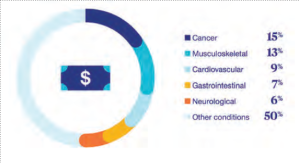Study reveals top five clinical conditions drive 50% of employers’ costs
BY PATTY STARR and CRAIG KURTZWEIL
In an extensive analysis of patient claims data, health plan member engagement has emerged as employers’ single best practice solution for controlling costs and improving outcomes for their employees. In the fifth joint white paper by the Health Action Council and UnitedHealthcare, a comprehensive analysis of 320,000+covered lives identified 50% of nearly $2 billion in cost to employers was limited to five conditions.
CLICK ON THE CHART TO ENLARGE
The study, “Costly Conditions: Identifying and Addressing Top Clinical Cost Drivers” (healthactioncouncil.org/News/Health-Action-Council-and-UnitedHealthcare-Release) offers insights into why employer cost varies so widely across gender, age, income, geography, and social determinants of health. In addressing these dominant conditions, the report shows why individual communities matter so much in terms of total cost of care, billing patterns, treatments, and outcomes. In addition to the “why,” the report shows how employers can reduce costs by encouraging more employee engagement.
Best-practice recommendations
Long-term research by UnitedHealthcare and Health Action Council clearly confirms that policies and practices that shed more light on care and cost choices produced better results for both employers and employees.
Access to better information through innovative resources, industry collaborations and ongoing research advances healthcare equity and reduces costs. Wider access and visibility empowers people to make more informed health and wellness decisions.
For employers, management and budget priorities should focus on these strategic imperatives:
- Transparency:
Empowering people with more information about their care options may help everyone make more informed decisions and save money. Integrated online resources available today provide personalized wellness support, decision-making power, and comparison-shopping options for employees.Employers can achieve significant gains by providing tools for employees to evaluate providers, treatment options and cost estimates of medical services. - Engagement:
Encouraging employee engagement/activation helps optimize plans and incentives. For example, the UnitedHealthcare HAI(tm) tool evaluates 53 evidence-based decisions as well as life-stage, demographic, and social determinants, to identify under-engaged individuals and groups. The report shows that highly activated patients are significantly less costly, and far healthier, than those lower on the activation scale. introducing pharmacy step therapies to support the use of high-quality, lower-cost generics or biosimilars before turning to more expensive solutions. Also, look for differences in practice patterns by geographic region (over- and undertreating; low adoption of best practices) when targeting high-cost conditions. Did you know that neurological treatment differs greatly by location? For example, patients in Greensboro are eight times more likely to have carpal tunnel surgery than people in Phoenix. Billed charges also vary widely.The average billed by providers in Los Angeles is four times higher than Philadelphia for the same procedure code. - Advocacy:
Employers should also make sure their employee health strategy includes a commitment to helping their workers navigate the healthcare system. Using advocacy, clinical resources and advanced algorithms to identify the next best action steps personalized to each member, can go beyond basic customer service. These tools help develop a deeper understanding of an individual and their needs, including social needs, to deliver personalized guidance.The goal is to create a simpler experience, so a person can:
• make more informed health decisions
• improve their health
• connect with relevant clinical programs
• avoid unnecessary costs
• understand lower-cost treatment options
• find community resources
The bottom line for employers
Although healthcare costs can be challenging for any business, the white paper identifies the top five clinical cost drivers. It provides employers with actionable steps on how to address these conditions to help improve employee well-being and lower costs. These steps include providing better price-tag transparency and employee engagement tools. Using analytics and oversight of factors ranging from location of care to drug prices can lead to measurable improvements in health outcomes and cost-of-care affordability.
Employers can learn more about how to lower costs and help employees achieve better health by reading the full white paper here: healthactioncouncil.org/News/Health-Action-Council-and-UnitedHealthcare-Release.

PATTY STARR is president and CEO, Health Action Council.

CRAIG KURTZWEIL is VP of UnitedHealthcare Center for Advanced Analytics.
Health Action Council is a not-for-profit organization representing large employers to enhance human and economic health through thought leadership, innovative servicazes, and collaboration. UnitedHealthcare is dedicated to helping people nationwide live healthier lives by simplifying the health care experience.

